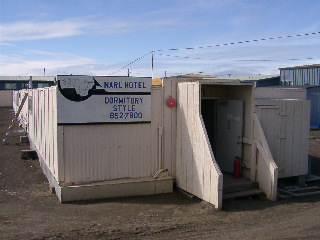
|
14 July, 2003Arrival in Barrow, Alaska 35 degrees F.; light snow gray, overcast After 15 hours travel time, including an overnight in the Anchorage airport, I finally arrived in Barrow, Alaska. The airplane going to Barrow was a 737 jet, but there were only about 50 people on board. Most of the space on the aircraft was used for cargo, the majority of which was food. The 7-hour flight from Atlanta, GA to Anchorage was beautiful. We flew over Canada and the Alaska Range. Passengers constantly shifted from one side of the airplane to the other in order to view the spectacular snow-covered mountain peaks and majestic glaciers. I have never seen such beautiful landscape. Flying into Barrow was quite different. Miles of apparently barren tundra extended in all directions, the predominant colors were mud-browns and mottled greens. The flat ground had distinct polygonal patterns that could be seen from several thousand feet. These patterns are the result of the cyclical freezing and melting of the soil. Each polygon had a somewhat raised rim while the interior seemed slightly depressed. I would like to investigate these features first-hand as my impressions from the air may not be accurate. We landed at the Will Rogers Airport and made our way into the one room terminal. Several people on the flight were just coming to Barrow for the day for "Tundra Adventure Tours." Tour guides and leaders collected their groups and headed out in tundra buses. I was greeted by Daniel Fowler, a member of the of Aerosonde team. My journey to the Town of Barrow was about to begin. It was an interesting drive from the airport. The only paved road in Barrow is the airport runway, other roads are made of black gravel. Daniel says that when wet they become impassable in places. The base turns to goo and vehicles get stuck before you know it. The most noticeable structure in Barrow is the "Utilidor" - an above-ground pipeline that encircles the town and provides a corridor for electrical systems, communications, and various types of infrastructure. We drove past the "poo pond", the sewage lagoon for Barrow. There is no waste treatment facility here. Everything is dumped into the lagoon or put in the landfill. I have not detected the characteristic odors associated with sewage ponds or landfills, perhaps because it is dry and cold - even on a summer day in July. Buildings in Barrow are modular, plywood or metal structures on stubby stilts. The town is cluttered with items in differing states of usability - timbers, freight containers, abandoned vehicles, metal drums, plastic, and various types of unidentifiable "stuff". At first glance, Barrow looks like an on-going construction project. I am sure that I will soon make sense of the environment. According to Daniel, there are no polar bears in the area as they have already gone out on the ice to hunt. It should be safe to walk about the village, but he did caution me to always let someone know where I plan to go. We passed by the elementary and middle schools on the way to the Hotel and BASC facility. The schools look almost new. Downtown Barrow has a bank, grocery/department store, municipal building, hospital, community center, and heritage hall. There is even a Mexican Restaurant. Daniel gave me a brief tour around the BASC and ARM facilities. He introduced me to the members of the Aerosonde team already here in preparation for this week's mission. David Wright, Dennis Hipperson, and Brett Solanov are busy with final preparations and adjustments to the aircraft and its on-board components before flights begin. Go to http://www.aerosonde.com/drawarcticle/78 to see images of the workshop, the Barrow shoreline, and these delightful and considerate members of the Aerosonde Air Force. I will enjoy working with them during the next several days. After checking into the NARL Hotel, living quarters for visiting scientists working on projects at any of the many research facilities in Barrow, Room 13 (I hope that this is not significant), I got an ID card and meal tickets, and then had lunch at the Ilsigavik College dining hall. All of our meals will be here; the food is plentiful and very good. After dinner we attended a talk by Dr. Mike Castellini, visiting Professor of Marine Biology at the University of Alaska in Fairbanks. Dr. Castellini conducts research on seals and penguins in Antarctica. His presentation focused on the different species of seals and penguins and how they differ in behavior, habitat preference, and physiology. Scientists from BASC, parcticularly the wildlife biologists, were full of questions, and the lecture quickly turned into an interactive classroom - a good ending for my first day in Barrow.
Contact the TEA in the field at . If you cannot connect through your browser, copy the TEA's e-mail address in the "To:" line of your favorite e-mail package. |





